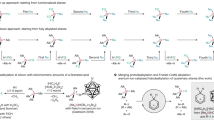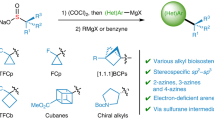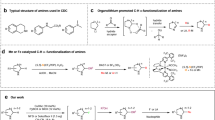Abstract
This protocol describes a method for the direct silylation of the carbon–hydrogen (C–H) bond of aromatic heterocycles using inexpensive and abundant potassium tert-butoxide (KOt-Bu) as the catalyst. This catalytic cross-dehydrogenative coupling of simple hydrosilanes and various electron-rich aromatic heterocycles enables the synthesis of valuable silylated heteroarenes. The products thus obtained can be used as versatile intermediates, which facilitate the divergent synthesis of pharmaceutically relevant compound libraries from a single Si-containing building block. Moreover, a variety of complex Si-containing motifs, such as those produced by this protocol, are being actively investigated as next-generation therapeutic agents, because they can have improved pharmacokinetic properties compared with the original all-carbon drug molecules. Current competing methods for C–H bond silylation tend to be incompatible with functionalities, such as Lewis-basic heterocycles, that are often found in pharmaceutical substances; this leaves de novo synthesis as the principal strategy for preparation of the target sila-drug analog. Moreover, competing methods tend to be limited in the scope of hydrosilane that can be used, which restricts the breadth of silicon-containing small molecules that can be accessed. The approach outlined in this protocol enables the chemoselective and regioselective late-stage silylation of small heterocycles, including drugs and drug derivatives, with a broad array of hydrosilanes in the absence of precious metal catalysts, stoichiometric reagents, sacrificial hydrogen acceptors or high temperatures. Moreover, H2 is the only by-product generated. The procedure normally requires 48–75 h to be completed.
This is a preview of subscription content, access via your institution
Access options
Subscribe to this journal
Receive 12 print issues and online access
$259.00 per year
only $21.58 per issue
Buy this article
- Purchase on Springer Link
- Instant access to full article PDF
Prices may be subject to local taxes which are calculated during checkout







Similar content being viewed by others
References
Bergman, R.G. Organometallic chemistry: C–H activation. Nature 446, 391–393 (2007).
Godula, K. & Sames, D. C–H bond functionalization in complex organic synthesis. Science 312, 67–72 (2006).
Labinger, J.A. & Bercaw, J.E. Understanding and exploiting C–H bond activation. Nature 417, 507–514 (2002).
Cheng, C. & Hartwig, J.F. Catalytic silylation of unactivated C–H bonds. Chem. Rev. 115, 8946–8975 (2015).
Langkopf, E. & Schinzer, D. Uses of silicon-containing compounds in the synthesis of natural products. Chem Rev. 95, 1375–1408 (1995).
Ball, L.T., Lloyd-Jones, G.C. & Russell, C.A. Gold-catalyzed direct arylation. Science 337, 1644–1648 (2012).
Denmark, S.E. & Baird, J.D. Palladium-catalyzed cross-coupling reactions of silanolates: a paradigm shift in silicon-based cross-coupling reactions. Chem. Eur. J. 12, 4954–4963 (2006).
Zhao, Z. & Snieckus, V. Directed ortho metalation-based methodology. Halo-, nitroso-, and boro-induced ipso-desilylation. Link to an in situ Suzuki reaction. Org. Lett. 7, 2523–2526 (2005).
Showell, G.A. & Mills, J.S. Chemistry challenges in lead optimization: silicon isosteres in drug discovery. Drug Discov. Today 8, 551–556 (2003).
Franz, A.K. & Wilson, S.O. Organosilicon molecules with medicinal applications. J. Med. Chem. 56, 388–405 (2013).
Whisler, M.C., MacNeil, S., Snieckus, V. & Beak, P. Beyond thermodynamic acidity: a perspective on the complex-induced proximity effect (CIPE) in deprotonation reactions. Angew. Chem. Int. Ed. Engl. 43, 2206–2225 (2004).
Cheng, C. & Hartwig, J.F. Iridium-catalyzed silylation of aryl C–H bonds. J. Am. Chem. Soc. 137, 592–595 (2015).
Cheng, C. & Hartwig, J.F. Rhodium-catalyzed intermolecular C–H silylation of arenes with high steric regiocontrol. Science 343, 853–857 (2014).
Lu, B. & Falck, J.R. Efficient iridium-catalyzed C–H functionalization/silylation of heteroarenes. Angew. Chem. Int. Ed. Engl. 47, 7508–7510 (2008).
Toutov, A.A. et al. Silylation of C–H bonds in aromatic heterocycles by an Earth-abundant metal catalyst. Nature 518, 80–85 (2015).
Järup, L. Hazards of heavy metal contamination. Br. Med. Bull. 68, 167–182 (2003).
Collins, K.D., Rühling, A. & Glorius, F. Application of a robustness screen for the evaluation of synthetic organic methodology. Nat. Protoc. 9, 1348–1353 (2014).
Zhang, F., Wu, D., Xu, Y. & Feng, X. Thiophene-based conjugated oligomers for organic solar cells. J. Mater. Chem. 21, 17590–17600 (2011).
Wang, Y. & Watson, M.D. Transition-metal-free synthesis of alternating thiophene-perfluoroarene copolymers. J. Am. Chem. Soc. 128, 2536–2537 (2006).
Acknowledgements
This work was supported by the US National Science Foundation (NSF) under the Centers for Chemical Innovation (CCI) Center for Selective C–H Functionalization (CCHF) (grant no. CHE-1205646) and under grant no. CHE-1212767. We thank the Novartis Institutes for Biomedical Research Incorporated for the donation of samples to the CCHF. A.A.T. is grateful to the Resnick Sustainability Institute at Caltech and to Dow Chemical for a predoctoral fellowship, and to the National Sciences and Engineering Research Council of Canada (NSERC) for a Postgraduate Scholarship-Doctoral Program (PGS D) fellowship. We thank the Shanghai Institute of Organic Chemistry (SIOC) and S.-L. You (SIOC) for a postdoctoral fellowship to W.-B.L. We thank S. Virgil and the Caltech Center for Catalysis and Chemical Synthesis for access to analytical equipment.
Author information
Authors and Affiliations
Contributions
A.A.T. and R.H.G. had the idea for and directed the investigations with W.-B.L. and B.M.S. A.A.T., W.-B.L. and K.N.B. developed the reactions, performed the experiments and analyzed the data. A.A.T. and W.-B.L. prepared the manuscript with contributions from all authors.
Corresponding authors
Ethics declarations
Competing interests
The authors declare no competing financial interests.
Rights and permissions
About this article
Cite this article
Toutov, A., Liu, WB., Betz, K. et al. Catalytic C–H bond silylation of aromatic heterocycles. Nat Protoc 10, 1897–1903 (2015). https://doi.org/10.1038/nprot.2015.118
Published:
Issue Date:
DOI: https://doi.org/10.1038/nprot.2015.118
This article is cited by
-
Phosphorus(III)-assisted regioselective C–H silylation of heteroarenes
Nature Communications (2021)
-
A potassium tert-butoxide and hydrosilane system for ultra-deep desulfurization of fuels
Nature Energy (2017)
Comments
By submitting a comment you agree to abide by our Terms and Community Guidelines. If you find something abusive or that does not comply with our terms or guidelines please flag it as inappropriate.



